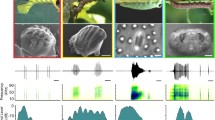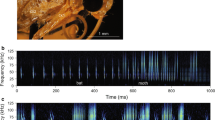Abstract
The tobacco hornworm (Manduca sexta) is a model organism extensively studied for many aspects of its biology, including its anti-predator strategies. We report on a novel component of this caterpillar’s defence repertoire: sound production. Late instar caterpillars produce discrete clicking sounds in response to disturbance. Click trains range in duration from 0.3–20.0 s (mean 3.3 ± 4.8 s) and contain 2–41 clicks (mean 7.1 ± 9.5). Sounds are broadband with a dominant frequency of 29.8 ± 4.9 kHz. We investigated the mechanism of sound production by selectively ablating three identified sets of ridges on the mandibles, and determined that ridges on the inner face strike the outer and incisor ridges on the opposing mandible to produce multi-component clicks. We tested the hypothesis that clicks function in defence using simulated attacks with blunt forceps. In single attack trials 77% of larvae produced sound and this increased to 100% in sequential attacks. Clicks preceded or accompanied regurgitation in 93% of multiple attack trials, indicating that sound production may function in acoustic aposematism. Sound production is also accompanied by other behaviours including directed thrashing, head curling, and biting, suggesting that sounds may also function as a general warning of unprofitability.






Similar content being viewed by others
References
Alexander RD (1960) Communicative mandible snapping in Acrididae. Science 132:152–153
Bernays EA (1991) Evolution of insect morphology in relation to plants. Phil Trans R Soc Lond B 333:257–264
Blondheim SA, Frankenberg E (1983) ‘Protest’ sounds of a grasshopper: predator deterrent signal? Psyche 90:387–394
Bowers MD (1993) Aposematic caterpillars: Life-styles of the warningly colored and unpalatable. In: Stamp NE, Casey TM (eds) Caterpillars: ecological and evolutionary constraints on foraging. Routledge, Chapman and Hall, Inc, New York, pp 331–371
Bowers MD (2003) Hostplant suitability and defensive chemistry of the Catalpa sphinx, Ceratomia catalpae. J Chem Ecol 29:2359–2367
Broughton WB (1963) Method in bio-acoustic terminology. In: Busnel RG (ed) Acoustic Behaviour of Animals. Elsevier, New York, pp 3–24
Brown SG, Boettner GH, Yack JE (2007) Clicking caterpillars: acoustic aposematism in Antheraea polyphemus and other Bombycoidea. J Exp Biol 210:993–1005
Bura VL, Fleming AJ, Yack JE (2009) What’s the buzz? Ultrasonic and sonic warning signals in caterpillars of the great peacock moth (Saturnia pyri). Naturwissenschaften 96:713–718
Bura VL, Rohwer VG, Martin PR, Yack JE (2011) Whistling in caterpillars (Amorpha juglandis, Bombycoidea): sound-producing mechanism and function. J Exp Biol 214:30–37
Dooling RJ (1991) Hearing in birds. In: Webster D, Fay R, Popper A (eds) The evolutionary biology of hearing. Springer, New York, pp 545–560
Goerlitz HR, Greif S, Siemers BM (2008) Cues for acoustic detection of prey: insect rustling sounds and the influence of walking substrate. J Exp Biol 211:2799–2806
Grant J (2006) Diversification of gut morphology in caterpillars is associated with defensive behavior. J Exp Biol 209:3018–3024
Kaby U, Lind J (2003) What limits predator detection in blue tits (Parus caeruleus): posture, task or orientation? Behav Ecol Sociobiol 54:534–538
Kalka M, Kalko EKV (2006) Gleaning bats as underestimated predators of herbivorous insects: diet of Micronycteris microtis (Phyllostomidae) in Panama. J Trop Ecol 22:1–10
Kingsolver JG (2007) Variation in growth and instar number in field and laboratory Manduca sexta. Proc R Soc B 274:977–981
Kirchner WH, Röschard J (1999) Hissing in bumblebees: an interspecific defence signal. Insectes Soc 46:239–243
Lederhouse RC (1990) Avoiding the hunt: primary defenses of Lepidopteran caterpillars. In: Evans DL, Schmidt JO (eds) Insect defenses: adaptive mechanisms and strategies of prey and predators. State University of New York Press, New York, pp 175–190
Masters WM (1979) Insect disturbance stridulation: its defensive role. Behav Ecol Sociobiol 5:187–200
Masters WM (1980) Insect disturbance stridulation: characterization of airborne and vibrational components of the sound. J Comp Physiol 135:259–268
Nishida R (2002) Sequestration of defensive substances from plants by Lepidoptera. Annu Rev Entomol 47:57–92
Pittaway AR (1993) Hawkmoths of the Western Palaearctic. Harley Books, England
Roth LM, Eisner T (1962) Chemical defenses of arthropods. Annu Rev Entomol 7:107–136
Rothschild M, Aplin R, Baker J, Marsh N (1979) Toxicity induced in the tobacco horn-worm (Manduca sexta L.) (Sphingidae, Lepidoptera). Nature 280:487–488
Ruxton GD (2009) Non-visual crypsis: a review of the empirical evidence for camouflage to senses other than vision. Phil Trans R Soc B 364:549–557
Schwartzkopff J (1955) On the hearing of birds. Auk 72:340–347
Stamp NE (2001) Effects of prey quantity and quality on predatory wasps. Ecol Entomol 26:292–301
Stamp NE, Wilkens RT (1993) On the cryptic side of life: Being unapparent to enemies and the consequences for foraging and growth of caterpillars. In: Stamp NE, Casey TM (eds) Caterpillars: ecological and evolutionary constraints on foraging. Routledge, Chapman and Hall, Inc, New York, pp 283–330
Sword GA (2001) Tasty on the outside, but toxic in the middle: grasshopper regurgitation and host plant-mediated toxicity to a vertebrate predator. Oecologia 128:416–421
Thaler JS, Griffin CAM (2008) Relative importance of consumptive and non-consumptive effects of predators on prey and plant damage: the influence of herbivore ontogeny. Entomol Exp Appl 128:34–40
Thurston R, Prachuabmoh O (1971) Predation by birds on tobacco hornworm larvae infesting tobacco. J Econ Entomol 64:1548–1549
Tuttle JP (2007) The Hawk Moths of North America. The Wedge Entomological Research Foundation, Washington DC
Walters ET, Illich PA, Weeks JC, Lewin MR (2001) Defensive responses of larval Manduca sexta and their sensitization by noxious stimuli in the laboratory and field. J Exp Biol 204:457–469
Wilson JM, Barclay RMR (2006) Consumption of caterpillars by bats during an outbreak of western spruce budworm. Am Midl Nat 155:244–249
Acknowledgements
We thank Ed Bruggink for providing the host plants and two anonymous reviewers for helpful comments. The Natural Sciences and Engineering Research Council of Canada (CGS M to V.L.B.; Discovery Grant to J.E.Y.), the Canadian Foundation for Innovation (J.E.Y.), and the Ontario Innovation Trust (J.E.Y.) provided funding.
Author information
Authors and Affiliations
Corresponding author
Rights and permissions
About this article
Cite this article
Bura, V.L., Hnain, A.K., Hick, J.N. et al. Defensive Sound Production in the Tobacco Hornworm, Manduca sexta (Bombycoidea: Sphingidae). J Insect Behav 25, 114–126 (2012). https://doi.org/10.1007/s10905-011-9282-8
Revised:
Accepted:
Published:
Issue Date:
DOI: https://doi.org/10.1007/s10905-011-9282-8




